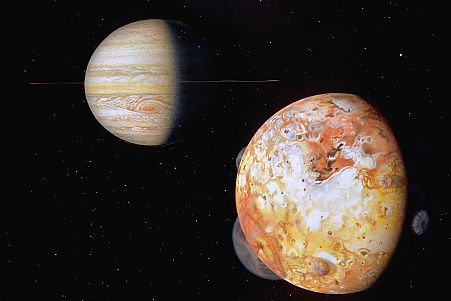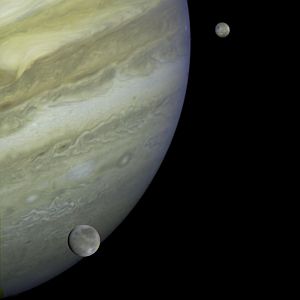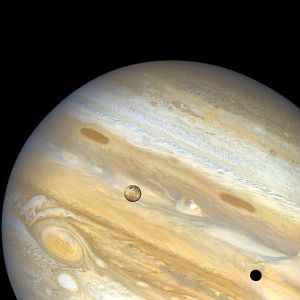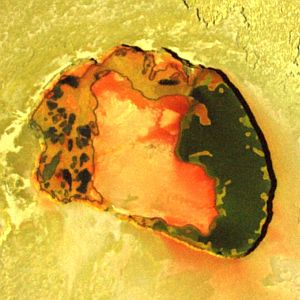
Für eine deutsche Übersetzung dieser Seite einfach die Brandenburger Flagge anklicken
 |
Click the Brandenburg Flag for a German translation Für eine deutsche Übersetzung dieser Seite einfach die Brandenburger Flagge anklicken |


|
|
IoA collection of pictures of Jupiter's moon Io,
|
|



|
Io is the innermost of Jupiter's four
Galilean moons. Due to extreme tidal heating, Io is the most geologically active object in the Solar System having over 400 active volcanoes. The first active volcanoes on a world other than earth was discovered during the flyby of Voyager 1 in March 1979. Here are our favorite pictures of Io. Like our other space galleries, the pictures have not been selected because of their scientific significance but because of their esthetic value and sometimes because of their historical importance. The picture to the left is a mosaic compose of images taken by the Galileo space probe on September 7, 1996 and November 6, 1996. / Source: JPL / NASA |

|
Io was discovered on January 8, 1610 by Galileo Galilei. The Galilean moons were the first
discoveries of moons in the solar system other than Earth's moon. They also were the first objects discovered using a telescope. For the next 350 years, due to the limited resolution of telescopes, Io and the other Galilean moons remained nothing more than light spect in a telescope. |

|
In the early 1960s, French astronomer Audouin Dollfus at the
Pic du Midi Observatory in the French Pyrenees created the first
crude map of Io, showing a patchwork of bright and dark spots across the surface, a bright equatorial belt and dark polar regions. Dollfus' drawing was confirmed by a picture taken by Pioneer 11 during its flyby on December 2, 1974. But still the best pictures of Io were only a few pixels across. |
  First map of Io drawn by Audouin Dollfus in the 1960s Source: Planetary and Space Science Volume 46, Issue 8, Pages 1037-1073 August 1, 1998 |
  First images of Io taken by a space craft Pioneer 11,December 2, 1974 distance: 314,000 km (195,000 mi) Source: NASA / Wikipedia |


| The first closeup pictures of Io were delivered by Voyager 1, which passed Io on On March 5, 1979 at a distance of 20,600 km (12,800 mi). |

  Artist's concept of Voyager 1's flyby of Jupiter and its moons Source: blog.bosch-si.com / Depositphotos / Elenarts |
  Artist's concept of Io with volcanic eruptions in front of Jupiter Source: Donald Davis |

  Io (back) and Ganymede (front) orbiting Jupiter February 22, 19792 Source: NASA / JPL / J. Roger |
  Io in front of Jupiter Distance 8.3 million km Source: NASA Astronomy Picture of the Day |
  Io above Jupiter with shadow below Distance 1 million km, March 4, 1979 Source: NASA / Planetary Society |

|
On March 8, 1979, Voyager 1 took images of Jupiter's moons meant for optical navigation. When navigation engineer Linda Morabito enlarged the images, she discovered a 300-kilometer (190 mi) tall cloud along the moon's limb. It was later determined to be a plume generated by an active volcano, the first one discovered outside Earth. Analysis of other Voyager 1 images showed a total of nine volcanoes. Today, we know of twelve eruptive centers on Io. The Planetary Society hosts a large collection of images taken by the Voyager probes. |
  Voyager 1: First volcanic plume discoveed on Io March 8, 1979, from 4.5 million km (2.6 million mi.) Source: NASA / JPL |
  Voyager 2: Three volcanic plumes on Io July 10, 1979, distance: 1.2 million km (750,000 mi) Source: NASA / JPL |

  Mosaic of Io's south polar region with Haemus Mons Source: NASA / JPL |
  Volcanic plains and Galai Patera Source: NASA / JPL |
  Volcanic eruption, March 4, 1979 Source: NASA / JPL |


|
NASA's Galileo probe entered Jupiter's orbit on December 8, 1995 and remained in orbit until September 21, 2003.
|

|
With Io being Jupiter's innermost moon, the radiation environment near Io was strong enough to potentially cause permanent damage to the spacecraft.
Thus, these flybys were saved for the extended mission when loss of the spacecraft would be more acceptable. Galileo's closest approach to Io happened on October 15, 2001, when the probe passed the moon in a distance of 180 km (110 mi). Three months later, on January 17, 2002 Galileo's cameras were deactivated due to irreparable radiation damage. The Planetary Society and the JPL Photo Journal host large collections of images taken by Galileo. |
  Artist's rendering of Galileo flying past Io Source: NASA / JPL |
  Anti-Jovian hemisphere of Io; February 20, 1997, Source: NASA / Planetary Society |

  Culann Patera Region; October 16, 2001 Source: NASA / Planetary Society |
  Tvashtar Paterae; February 22, 2000 Source: NASA / Planetary Society |
  Tupan Patera October 16, 2001 Source: NASA / Planetary Society |
  Eruption and lave flow at Tvashtar Paterae February 22, 2000 Source: NASA / Planetary Society |
  Zal Patera March 6, 2000 Source: NASA / Gishbar Times |


|
Aside from the Pioneer and Voyager probes and the two satellites Galileo and Juno, the only spacecraft that came somewhat close to Io, was
New Horizons, which passed Jupiter on Februay 28, 2007 in a gravity assist
maneuver. Four days before its closest approach, the probe took a series of color images of Io from distances between 7.8 million km and 6.6 million km. On Februay 28, 2007, New Horizon's LORRI camera, developed for very dim light, captured an eruption of Io's volcano Tvashtar. |
 Source: Source:unmannedspaceflight.com |
 Source: Source:Wikipedia |


|
The second closest of the Galilean moons is Europa.
It is the smallest of the four large moons. It cracked icy surface suggest an ocean of liquid water |

|


|
|
Click here to return to Jupiter's orbit | Click here to move on to Jupiter's moon Europa |
|

|
Back to Solar System Page |
Back to Space Page |
Back to English Main Page |
 Back to Start Page |